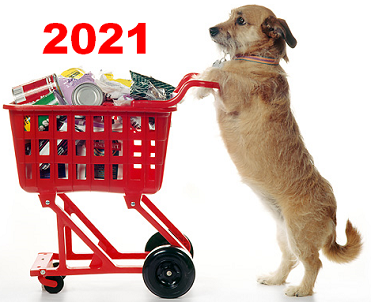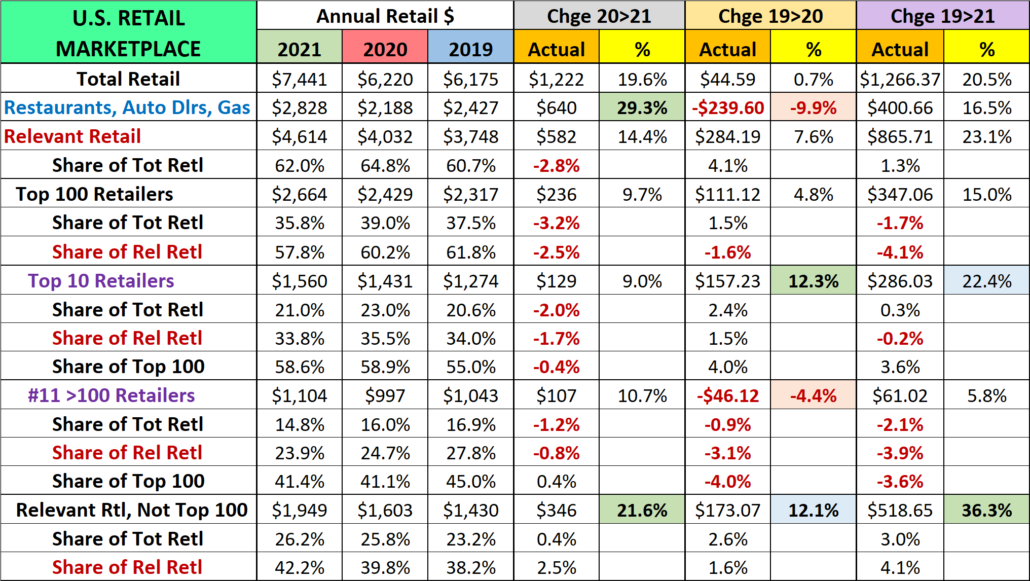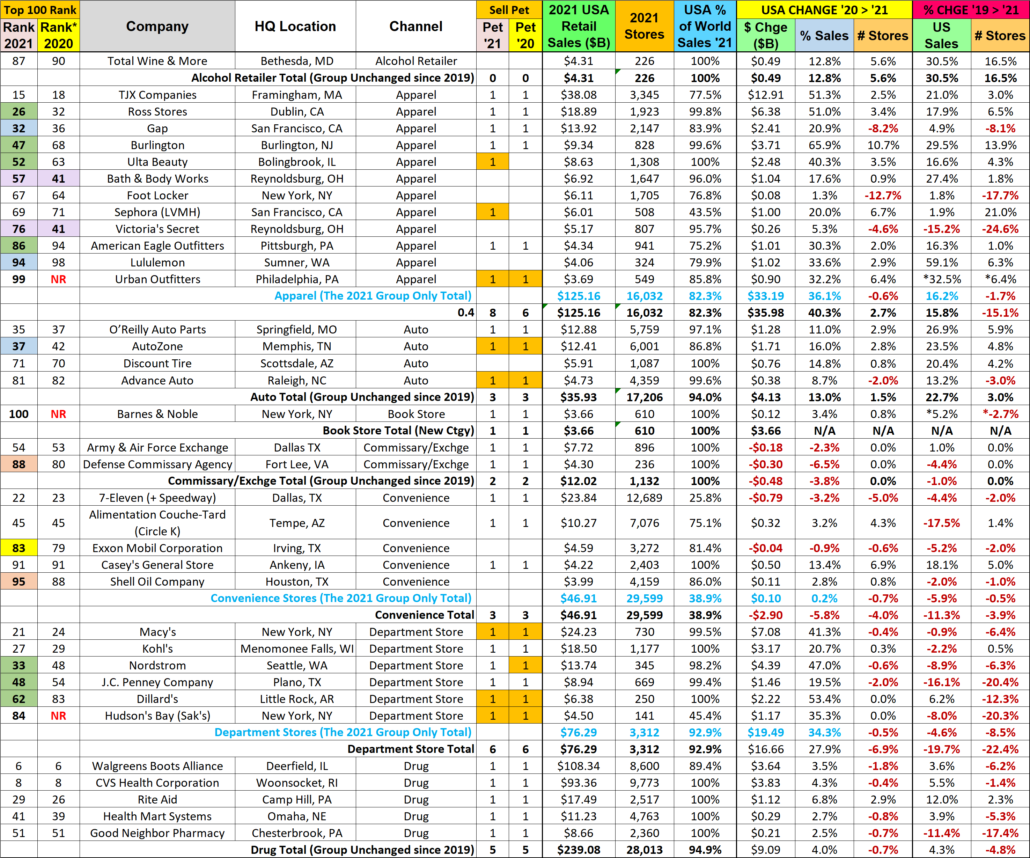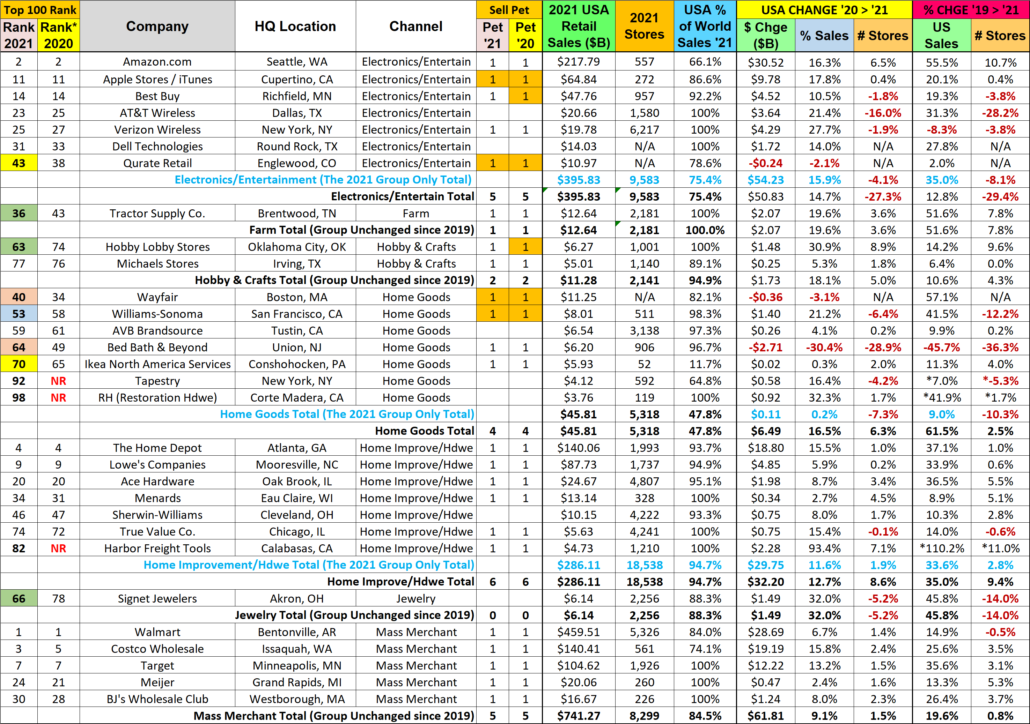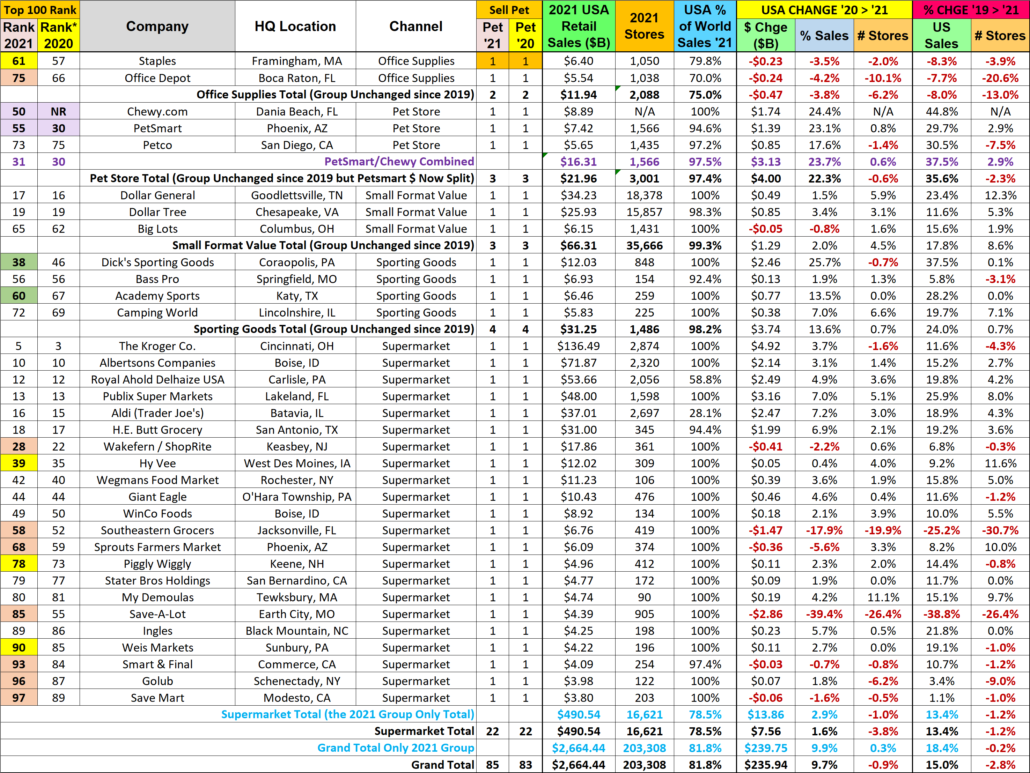2021 Top 100 U.S. Retailers – Sales: $2.66 Trillion, Up 9.7% 162,495 Stores with Pet Products……plus the Internet!
The U.S. Retail market reached $7.44 Trillion in 2021 from all channels – Auto Dealers, Supermarkets, Restaurants, Online retailers and even Pet Stores. Thanks to a strong, widespread pandemic recovery, this year’s increase of $1.22T (+19.8%) was far above last year’s increase of $44.6B (+0.7%). In 2020 the Total Retail Market was massively negatively impacted by COVID related closures and restrictions and only eked out a positive number because of increased spending in the Relevant Retail Segment. In 2021 there was a stronger and more balanced resurgence. (Data courtesy of the Census Bureau’s monthly retail trade report.)
In this report we will focus on the top 100 Retailers in the U.S. Market. The base data on the Top 100 comes from Kantar Research and was published by the National Retail Federation (NRF). In 2020, Restaurants were removed from the list and only Gas Stations with Convenience stores were included. To allow continued comparisons to pre-pandemic 2019, I used the data to create a revised “Restaurant Free” 2019 list. The Top 100 are the retail elite and still account for 35.8% of the total market, which is down from a record 39.0% in 2020. The vast majority of the group also stock and sell a lot of Pet Products. Let’s get started in our analysis. The report does contain a lot of data, but we’ll break it up into smaller pieces to make it more digestible.
In past years we have begun our report with a brief overview chart of this year’s sales vs the previous year’s numbers. However, the pandemic effect on the retail trade has indicated that we should look a little deeper. The U.S. Retail market has had a strong recovery from the 2020 trauma and the resurgence has become widespread across most channels. We have seen in our regular retail sales reports that different defined retail channels often took a different path from 2019 to 2021. The Top 100 report allows us to see if the company revenue size was also a factor in their journey. The following chart is definitely an overview, but it is far more detailed than past years. It also covers the pandemic period from 2019 to 2021, including both $ and market share changes for large retail subgroups of the Relevant Retail Segment based upon the amount of annual revenue.
- The total Retail Market grew $1.2T, +19.6% in 2021. That is far greater than the $45B, +0.7% in 2020. The average growth rate since 2019 is 9.8%. That is more than double the rate of recent years: 2019, 3.6%; 2018, 4.9%; 2017, 4.3%. You can clearly see the strength of the recovery.
- The “Non-Relevant” Retail Group (Restaurants, Auto Dlrs, Gas Stations) was hit hardest by the pandemic, with sales falling $240B, -9.9% in 2020. However, they had an incredibly strong recovery in 2021 as sales grew $640B, +29.3%. They gives them an average annual growth rate of 7.9% since 2019.
- Relevant Retail was the hero of the pandemic. Their $284B increase in 2020 kept Total Retail positive for the year. Their sales surged even stronger in 2021 as they were up $582B, +14.4% producing an average growth rate since 2019 of +11.0%. However, their share of Total Retail fell 2.3% after peaking in 2020. As you can see, the story is a bit more complex. Let’s drill a little deeper.
- The Top 100 Retailers make up about 60% of the Relevant Retail Market. They have shown consistent growth since 2019 with a surge of $236B, +9.9% in 2021. Their average growth since 2019 is +7.2%, which is good but not good enough. They have lost considerable share in both Total and Relevant Retail. Let’s drill even deeper.
- The biggest subgroup in the Top 100 is the Top 10 which accounts for 55+% of the Top 100’s revenue. This group has been unchanged since 2015 and consists of Amazon, plus truly essential brick ‘n mortar retailers. Their biggest sales surge occurred in 2020. Sales grew 9.0% in 2021 but their share of revenue decreased in Total and Relevant Retail. Their average growth rate since 2019 is +10.6% which did produce a 3.6% share gain in Top 100 $.
- The Retailers ranked from #11 to #100 changes slightly every year. Their sales in 2021 ranged from $3.5 to $65B and they accounted for 41% of the Top 100’s revenue. They have an unusual sales pattern in that their $46B decrease in 2020 is the only negative sales on the chart outside of the big drop by Rest/Auto/Gas. They did have a strong 10.7% increase in 2021 which generated an average annual gain of +2.9%. However, they have lost significant share in Total & Relevant Retail. These companies are a major part of U.S. Retail. They can have big gains but also big losses.
- The Relevant Retailers outside of the Top 100 don’t get a lot of “press” but maybe they should. They currently account for 42% of Relevant Retail $ and 26% of Total Retail. Their 12.1% increase in 2020 was only slightly behind the Top 10 and their 21.6% increase in 2021 was more than double that of any other Relevant Retail subgroup. Their avg. increase since 2019 is +16.9%, the best of any group on the chart. While this performance is amazing, perhaps the most important fact is that they delivered 60% of Relevant Retail’s sales increase in 2020 AND from 2019>2021.
I hope that you now see why I chose to expand my overview. There is no doubt that the big retailers are critical to the success of the U.S. Retail Market. However, there are sometimes “hidden heroes” that should be noted.
The Top 100 outperformed the overall market in 2020 but not in 2021. In fact, the sales growth since 2019 trails Total Retail, Relevant Retail and even Rest/Auto/Gas. It still accounts for 35.8% of Total U.S. Retail $ so it is still critically important. We also should remember that the Top 100 is really a contest with a changing list of winners. Companies drop out and new ones are added. This can be the result of mergers, acquisitions, surging or slumping sales or even a corporate restructuring. In 2021, Speedway was acquired by 7-Eleven but 7 other companies dropped off the list.
- Guitar Ctr • GameStop • UNFI (Suprmkt) • Grocery Outlet (Suprmkt) • Belk (Dept Str) • Sears • AMPM (Conv)
On the plus side, PetSmart split into 2 separate companies – Chewy & PetSmart. L Brands also split as they now have separate listings for Bath & Body Works and Victoria’s Secret. Also, 6 new companies were added.
- Harbor Freight (Hdwe) • Hudson’s Bay (Dept Str) • Tapestry (Home Gds) • RH (Restoration Hdwe) (Home Gds)
- Urban Outfitters (Apparel) • Barnes & Noble (Books)
I think that we now have a good overview of U.S. Retail and the Top 100 so let’s ask and answer a very relevant question. How many Top 100 companies are buying and selling Pet Products? This will reinforce that Pets have become an integral part of the American Household and how fierce that the competition for the Pet Parents’ $ has become.
- We should note that the data in the chart reflects the performance of the companies in the 2021 list since 2019 and is not being compared to the Top 100 list of companies from prior years
- 85 are selling some Pet Products in stores and/or online. 2 of the companies added pet products to their offerings for the 1st time in 2021. Plus, 85 is 4 more companies than the 2020 list.
- Their Total Retail Sales of all products is $2.56 Trillion which is…
- 0% of the total business for the Top 100
- 4% of the Total Retail market and 55.4% of Relevant Retail – from 85 Companies who sell Pet Products.
- 72 Cos., with $2.39T sales sell pet products off the retail shelf in 162,495 stores – 9,000 more than 2020.
- As you can see by the growth in both sales and store count since 2019, “in store” is still the best way to sell pet.
- Online only is another story and the story gets complicated.
- Amazon includes Whole Foods, which has stores so the Amazon $ are in the “Pet in Store” numbers.
- 2 Retailers in the 2021 list added pet products to their offerings. This group had decreased sales and closed stores in 2020. Fortunately, 2021 brought a rebound in both areas, but especially in $ales.
- The group not selling pet products, led by electronics retailers like AT&T and Dell as well as specialty retailers like Signet Jewelers and Lulumon have had extraordinarily strong pandemic sales growth, especially in 2021. However, overall, the group continues to close stores. Perhaps, more of them with see Pet as a new growth opportunity.
- Their Total Retail Sales of all products is $2.56 Trillion which is…
Pet products are an integral part of the strongest retailers and are widespread across the entire U.S. marketplace. Of the Top 100, 162,495 stores carry at least some pet items at retail. However, there are thousands of additional “pet” outlets including 15,000 Grocery Stores, 9,000 Pet Stores, 16,000 Vet Clinics, 5,000 Pet Services businesses and more. Pet Products are on the shelf in over 210,000 U.S. brick ‘n mortar stores… plus the internet.
Before we analyze the whole Top 100 list in greater detail let’s take a quick look at the Top 10 retailers in the U.S.
Although the rankings often change due to the current market factors, this group has been incredibly stable. The list is unchanged since 2013, with one slight qualification. In 2015 Albertsons purchased Safeway. The new Albertsons/Safeway group replaced the stand-alone Safeway company in the list. Now let’s get into the numbers.
- Their Total Retail Sales were $1.56 Trillion which is:
- 6% of Top 100 $ales, down from the 2020 peak (58.9%) but up considerably from 2019 (55.0%).
- 8% of Relevant Retail, down from 35.5% in 2020 but about the same as 2019 (34.0%).
- 0% of Total U.S. Retail $, down from 23.0% in 2020 but again about the same as 2019 (20.8%).
- 2 Companies swapped rank – Costco & Kroger
- Amazon leads the way but sales are up for all, with the biggest growth coming in 2020 for all but Costco & Drug Strs.
- Store count was down for both years and -1.8% since 2019 – Driven by Kroger and the big Drug Chains.
These stores are truly essential to U.S. Consumers so it is no surprise that their influence peaked during the COVID crisis.
Now we will look at the detailed list of the top 100. We’ll sort it by retail channel with subtotals in key columns. For some channels there will be 2 subtotals. The subtotal in Blue compares the data history for just the 2021 list. The Black subtotal compares this year’s totals to those from previous year’s lists. We’ll then break it into smaller sections for comments. I have not done a lot of highlighting however:
- Pet Columns ’21 & ‘20 – a “1” with an orange highlight indicates that products are only sold online
- Rank Columns – 2021 changes in rank from the 2020 list are highlighted as follows:
- Up 4-5 spots = Lt Blue; Up 6 or more = Green
- Down 4-5 Spots = Yellow; Down 6 or more = Pink
Let’s get started. Remember, online $ are included in the sales of all companies.
Also Note:(*) in the 2019 columns of some previously unranked companies means the 2019 base was estimated from other data sources.
Observations
- Alcohol Retailers first made the list in 2020 as consumers started dining at home. The behavior is continuing.
- Apparel – They were hit hard by the pandemic but had a strong recovery in 2021. L Brands is now reported as 2 separate companies and Urban Outfitters was added. The overall loss of stores is coming from only 3 companies. BTW – The 2 companies that added Pet Products in 2021 are in the Apparel group – Ulta and Sephora
- Auto – Growth in both years with the biggest lift in 2021. The only negative is that Advance Auto is closing stores.
- Book Stores are back! Barnes & Noble made the list for the first time since 2015.
- Commissary/Exchanges – They put outlet changes on hold, and they are losing revenue, especially in 2021.
- Convenience Stores – 2020 & 2021 haven’t been very good for Convenience stores, especially those closely tied to Gas Stations. Speedway was acquired by 7-Eleven, but the combination has negative numbers across the board. AMPM dropped off the list. The only gains are coming from Casey’s, Circle K and Shell.
- The decline in Department Stores was accelerated by the pandemic. Sales rebounded in 2021 but only Dillard’s is ahead of 2019. Two chains dropped off the list, Belk and Sears. Sears has been a fixture in U.S. Retail since they began a mail order catalog in 1893. Now, their demise seems to be getting closer. There is some good news as Hudson’s Bay made it back to the Top 100. By the way, Kohl’s is the only company increasing their number of stores.
- Drug Stores – This group is essential but because visit frequency is low, changes in sales are generally small. The biggest lifts happened in 2021. Good Neighbor Pharmacy is the only group with a sales decrease since 2019. This was largely due to a reduction in stores. This trend is almost universal in the category as only Rite Aid added stores.
Observations
- Electronics/Entertainment – Strong growth in 2020 which continued in 2021. Overall store count declined in both years. Gamestop dropped out in 2021 and Amazon Web Services revenue was removed from their Retail $ in 2020.
- Amazon Retail growth was strong in 2021, +16.3% but it was only half of the +33.7% in 2020. In terms of brick ‘n mortar, their Whole Foods division continues to add stores.
- The sales pattern was different for the others on the list. The 2021 lift generally exceed the increase in 2020. Only Qurate had a sales decrease in 2021 but they are still up vs 2019. Only Verizon sold less in 2021 than in 2019.
- Regarding store count, Best Buy, AT&T and Verizon reduced their number of stores in both 2020 and 2021.
- Farm – Tractor Supply continues their strong pandemic sales growth and is opening new stores at a steady rate.
- Hobby & Crafts – Quite frankly, Hobby Lobby is the story in this group. While both companies are up in sales vs 2020 & 2019. The vast majority of the $ increase and 100% of the lift in store count were driven by Hobby Lobby.
- Home Improvement/Hardware – This group is incredibly positive as the only negative on the chart comes from True Value closing a few stores. The data reinforces that consumers focused on their homes, especially in 2020.
- Harbor Freight is growing fast and in 2021 earned a spot in the Top 100.
- Sales were up vs 2020 across the board with the biggest $ lifts coming from the 3 biggest guys & the newcomer.
- We should also note that the biggest % increases in $ since 2019 came from the same group.
- It is also a very healthy sign when 6 of 7 companies are adding more stores.
- Jewelry – Consumers obviously turned their attention to looking good, especially in 2021. However, if they bought from Signet, they had fewer brick ‘n mortar outlets available.
- Mass Merchants have 3 of the 7 largest volume retailers in America – Wal-Mart, Costco and Target. Prior to the pandemic Wal-Mart & Costco usually drove the growth in this channel. In 2021 we need to add Target to this group.
- In 2021 Wal-Mart had a 6.9% increase in sales, which is by far the lowest of the Big 3 and about the same as 2020. Their SuperCenter business was essential, so store sales increased, and their online sales took off. However, “regular” Discount Department Stores are losing market share. This impacts both Wal-Mart and Target so many outlets are adding more fresh groceries. They closed 100 stores in 2020. They opened 75 in 2021
- Costco had a strong increase in growth, +15.8% compared to +9.3% in 2020. They are also regularly opening more new stores, +3.5% since 2019.
- Target posted a 5th consecutive sales increase in 2021, +13.3%. This was down from +19.8% in 2020 but it pushed their lift from 2019 up to +35.6%, the largest in the entire group. They are also opening new stores and rapidly adding more fresh groceries to their Discount stores to enhance their consumer appeal.
- Meijer has the lowest growth in sales since 2019, 13.3% but the highest rate of store growth, +5.3%. Most of the growth in $ and stores occurred in 2020.
- BJ’s sales were up +8.0% in 2021. This is less than half of the +17.0% in 2020 but it was the 4th consecutive increase after a string of annual declines from 2013 to 2017. They also continue to strongly add more stores.
Observations
- Office Supply Stores – This channel continues its consistent decline as Consumers maintain their move to online ordering of these products. The drop in store count is also regular but even more severe, -13.0% since 2019.
- Pet Stores showed even stronger growth in 2021. Sales were up $4.0B (+22.3%) from 2020 and +35.6% from 2019. Most of the growth appears to be coming from online sales.
- In this year’s report, the sales from Chewy and PetSmart are reported individually as they are now separate companies. I included a PetSmart/Chewy listing to show the total sales for the “group” from 2019 to 2021.
- With the strong consumer movement to online purchasing, Chewy is the big story in this channel. Their growth got even stronger in 2021, +24.4% producing a net gain of 44.8% from 2019.
- PetSmart’s growth is getting stronger, +23.1% in 2021, almost matching Chewy. They are also expanding their retail footprint, with a 2.9% increase in stores since 2019.
- Petco’s growth since 2019, +30.5% is slightly ahead of PetSmart. Although the biggest lift came in 2021, +17.6% the growth is slightly more balanced. The big difference is that Petco cut back on their retail stores, especially in 2020. Their 2021 store count is down -7.9% from 2019.
- Small Format Value Stores – These stores offer both value and convenience, but their appeal peaked in 2020.
- Their sales increase fell to +2.0% from +15.5% in 2020 but the store count continues to grow, +8.6% from 2019.
- Dollar General’s sales growth, slowed from +21.6% to +1.5% but store growth stayed at 6%.
- Dollar Tree led in $ growth, +3.1% & added 3.1% more stores. But their growth since 2019 is ½ Dollar General’s
- Big Lots’ $ fell slightly from 2020, -0.8% but are still +15.6% from 2019. They added stores in both 2020 & 2021.
- Sporting Goods – The rates were mixed but all companies increased sales in both 2020 and 2021. The overall store count also grew in both years but the biggest increase in both areas came in 2021.
- The biggest sales lifts in 2021 and since 2019 came from Dick’s and Academy.
- Camping World finished 3rd in sales growth from 2019 but led the way in store openings.
- The only 2 negatives came in store count – Bass Pro in 2020, producing a 3% drop since 2019 and Dick’s in 2021.
- Supermarkets – The food “binge buying” was over so the 2021 sales increase fell to +1.6% from +10.6% and 2 companies dropped off the list – UNFI and Grocery Outlet. However, there are still 22 Supermarkets in the Top 100.
- In 2020 only Southeastern sold less. In 2021 there were 6 companies with decreased sales.
- 6 companies also cut back on stores producing a net drop of 650 stores from the 2020 list.
- With $490B in sales from 16,621 stores, all carrying Pet Products on their shelves, this group is truly essential – both to the overall U.S. Retail Market and the Pet Products Industry.
Wrapping it up!
This report is focused on 2021 but we can also see the evolving impact of the pandemic. In 2020 it caused trauma for many retailers as non-essential stores were hit with restrictions and closures. On the plus side, consumers turned their focus to essentials and their homes. This helped drive incredible growth in many retail channels.
In 2021 the Total Retail market moved into a full recovery with spectacular growth. Many channels showed a strong sales rebound from 2020. Others built upon their pandemic success while many returned to a more normal growth pattern. However, a few continued to decline. The Top 100 companies had participants in all of these patterns.
The Top 100 is a contest with the winners changing slightly every year. It is a critical part of the U.S. Market, accounting for about 60% of Relevant Retail Revenue and almost 40% of the Total Retail Market. However, the pandemic also impacted the overall influence of the group in the marketplace.
Sales increased annually but the Top 100’s share of Total Retail peaked in 2020 and has steadily declined in Relevant Retail. It turned out that the Top 10 (Consistent annual growth) and #11>100 (Down in 2020, up in 2021) have radically different sales patterns. We also found a new hero – Relevant Retail not in the Top 100. The small guys can also lead.
Pet Products are an important part of the success of the Top 100. 85 companies on the list sell Pet Products in 162,495 stores and/or online. The 72 companies that stock pet products in their stores generated $2.39T in total sales. How much was from pet? Let’s “Do the math”. If we take out the $22B done by PetSmart & Petco, and the remaining companies generated only 1.7% of their sales from Pet, we’re looking at $36.9B in Pet Products sales from only 69 “non-pet” sources! (The 1.7% share for Pet is an estimate based on the last Economic Census.) If you add Pet Stores back in, Total Pet Products sales for the Top 100 are $57.5B. The APPA reported $78B in Pet Products sales for 2021. That means 69 mass market retailers accounted for 47.3% of all the Pet Products sold in the U.S. and 72 Top 100 companies generated 73.8%. Pet Products are widespread in the retail marketplace but the $ are concentrated. All Pet Industry participants should monitor the Top 100 group.
Retail sales $ are increasing in 2022 but runaway inflation has now become a major factor. We’ll see what changes that this unexpected situation brings to the retail market and the Top 100.
The Top 100 is an important part of U.S. Retail I hope that this detailed look help put this group into better perspective.

